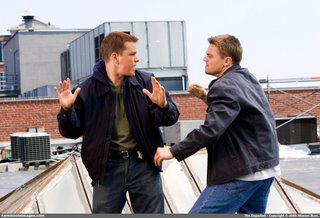 If wishes were eccentric uncles, bankers would make wine. That, in a nutshell, is the one line plot summary of Ridley Scott's 'A Good Year'. So you don't have to fear spoiling your movie experience by reading this review. From the moment MaX Skinner, investment banker of low scruples and greed extraordinaire, inherits the French chateau inhabited by a once-dear uncle, you know.
If wishes were eccentric uncles, bankers would make wine. That, in a nutshell, is the one line plot summary of Ridley Scott's 'A Good Year'. So you don't have to fear spoiling your movie experience by reading this review. From the moment MaX Skinner, investment banker of low scruples and greed extraordinaire, inherits the French chateau inhabited by a once-dear uncle, you know.Sod is gonna fall in love with the estate, with the idea of living the 'simple life', with France, and possibly a French girl. All of the above happen in due course, so all I can offer you is an opinion on whether it holds your interest.
The answer is yes, but not wholly, or in full measure. You don't come out of the theatre feeling either entertained or highly elevated. The problem is it's too predictable, and full of stereotypes.
Take Max Skinner. A bigger caricature of an investment banker I have scarcely seen. The guy walks into the dealing room, declares 'today is greedy bastard day' and proceeds to make a trade which is borderline illegal. The guy has no friends, no family, no love life, no other interests except making money.
I mean, sure, there might be some people as weird as him out there but there's hardly a moment when you feel anything for this character. And it's not clear why he is the way he is. Except for the fact that his parents died young and his only relative in the world was his old uncle.
 The moment our man steps into the chateau he is flooded by memories of summers spent as a boy with his uncle. And yet, he did not call or meet the man for the last ten years before he died. "Because I turned into an arsehole". Truth is, he's not all that lovable - even as a kid, in flashback.
The moment our man steps into the chateau he is flooded by memories of summers spent as a boy with his uncle. And yet, he did not call or meet the man for the last ten years before he died. "Because I turned into an arsehole". Truth is, he's not all that lovable - even as a kid, in flashback. Anyhow, Max makes a trip to the chateau to assess how much he could sell it for. Thanks to a series of circumstances, including being stranded at the bottom of an empty swimming pool, he ends up staying a week. And you know.. the wine, weather and women factor works on him.
Anyhow, Max makes a trip to the chateau to assess how much he could sell it for. Thanks to a series of circumstances, including being stranded at the bottom of an empty swimming pool, he ends up staying a week. And you know.. the wine, weather and women factor works on him. There is a slight complication when 'Christy Roberts', Henry's illegitimate American daughter also shows up. But there are no villains in the piece - not even Monseuir et Mme Duflot who I truly thought were cheating the Skinners by bottling inferior wine under the Chateau Sauvignon label. Never mind - if u see the movie, you'll understand.
 And hey, you can see the film simply for:
And hey, you can see the film simply for:- The gorgeous French countryside
- The gorgeous French girl Skinner falls for (Marion Cotillard)
- The glimpse of life in France which truly seems kinder, gentler and as full of sparkle as their wine.
The scene where the housekeeper Mmm Duflot does a li'l jig as she cleans the kitchen, the open air cafe where Max and his girl go on their first date, and the restaurant she runs for a living - all of them make you want to cash out your Provident fund and queue up for an immigrant visa to France.
Alas, the many stupidities of the film bring you back to earth whenever you get slightly intoxicated. Russell Crowe looks old, overweight and unshaven. His secretary "Jemma" aka Jasminder who hogs a fair bit of screen time, is horrendous. You'll be able to tell from the moment she opens her mouth "Oh, she's Indian". The vaguely familiar actress is 'Archie Panjabi' - best known as the sister in 'Bend it like Beckham'.
 Speaking of weird names, could the makers of the film find no better nom de film for the French girlfriend than 'Fanny Chanel'?? I mean, really, that's the sort of thing you expect from James Bond...
Speaking of weird names, could the makers of the film find no better nom de film for the French girlfriend than 'Fanny Chanel'?? I mean, really, that's the sort of thing you expect from James Bond... Net: net, you can watch 'A Good Year', but you don't have to. Especially if you're on the right side of 25. For the yuppie types, 'A Good Year' is not compelling but neither is it dangerous. You won't be inspired to run off and settle down on a farm in Satara anytime soon.
Given real estate prices in Mumbai right now, my 'kindly old uncle kicks the bucket' fantasy involves a 2000 sq ft 'chateau' in Le Malabar Hill... Sadly, no such uncles!








